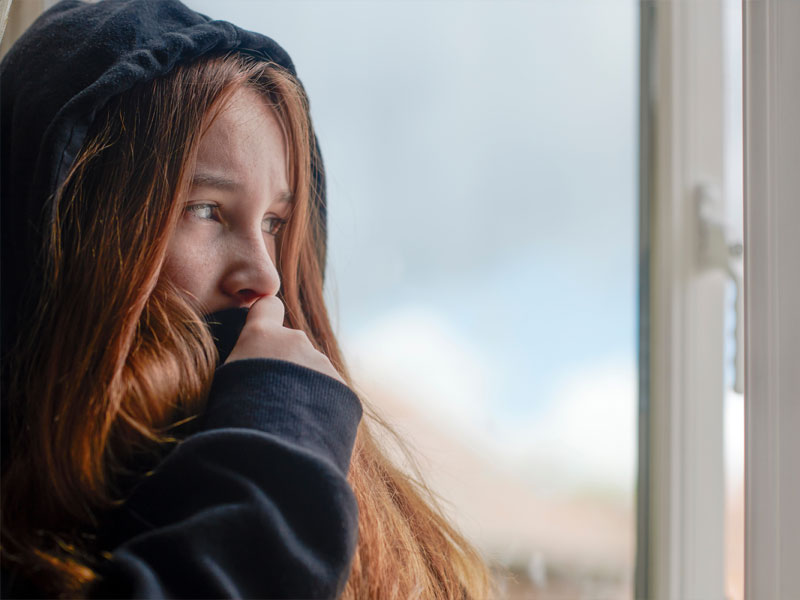
Sophie was 13 years old when KidsAid began working with her, referred by her school to address the deep emotional trauma she had endured during her early childhood.
Sophie’s life had been shaped by unimaginable hardship. In 2018, she was removed from her mother’s care after her school alerted child services when Sophie arrived with untreated wounds. In hospital, Sophie bravely shared the abuse she had suffered—enduring physical punishment, witnessing repeated domestic violence, and being abandoned at home for long stretches of time. She was malnourished, unclean, and left to fend for herself. After her removal, Sophie was placed in foster care, but her journey remained turbulent. Over the following three years, several foster placements broke down, each move amplifying her anxiety and distress. Constantly uprooted, Sophie struggled to build trust, both with adults and with her peers.
When Sophie was referred to KidsAid, she had just been placed with her foster carer, Jill, who was eager to support Sophie’s healing.
The initial assessment included a carer assessment to explore Sophie’s attachment, developmental milestones, and home environment, as well as a risk assessment to ensure her safety. Sophie’s therapist also observed her emotional regulation and behaviours in a structured session. Both Jill and Sophie’s schoolteacher expressed concern over Sophie’s distressing behaviours—scratching at her skin, pulling at her hair, and withdrawing from social interactions. Sophie’s avoidance of class and engagement with others became a major point of focus.
Strengths and difficulties questionnaires were completed by Jill and Sophie’s schoolteacher, providing a baseline to track Sophie’s progress. The assessment revealed significant challenges: attachment issues, anxiety, self-harming behaviours, and very low self-esteem.
Based on these findings, it was recommended that Sophie attend 30 weeks of creative therapy, offering her a safe, confidential space to process her trauma through art and play. The goal was to boost her self-esteem, reduce her anxiety, and give Sophie the opportunity to express herself freely.
In the beginning, Sophie was hesitant, her ability to trust was fragile and her defences were high. It took time for her to even consider making art, and she remained deeply withdrawn. But as sessions continued, Sophie slowly started to explore the space, testing boundaries and building trust with her therapist. By the fourth session, Sophie was using materials independently, gradually revealing her inner world through her artwork.
The first themes began to emerge: feelings of shame, guilt, and self-doubt dominated Sophie’s art. These powerful emotions were gently reflected by her therapist. Through careful challenge, Sophie began to explore the negative thoughts that had defined her self-image for so long.
Over time, Sophie began to connect the images she created with the feelings she had kept buried. As she painted, she found herself revisiting painful memories, but for the first time, they felt contained—safe within the boundaries of her art and the therapy space.
Around week 16, Sophie’s therapeutic journey took a pivotal turn. She began to use the sand tray and figurines to express herself. At first, Sophie buried the figures in the sand, hiding them from view. The sand tray became a place where her emotions felt buried and difficult to face. Over time, Sophie began to uncover the buried figurines, one by one, revealing them from the sand. Each figurine, once hidden, slowly emerged with greater clarity. This process mirrored Sophie’s growing ability to confront and process her emotions, bringing to light parts of herself she had kept hidden.
As Sophie uncovered each figurine, it symbolised her increasing self-awareness and her ability to reclaim the pieces of herself that had been buried under the weight of her past. By the end of her therapy, Sophie’s emotional landscape had shifted—just as the figurines had emerged from the sand, Sophie’s sense of self-worth was now shining through, stronger and more defined.
By the end of her therapy, Sophie could speak openly about the positive changes she had experienced. She proudly shared her achievements in class and the new friendships she had formed. Her self-talk was kinder, and her once-frequent episodes of self-harm became less and less frequent. Sophie had learned to regulate her emotions through techniques like breathing exercises and mindfulness, tools her therapist had introduced.
In her final session, Sophie spoke with a newfound sense of peace. She shared how therapy had allowed her to “leave” the weight of her painful memories behind, no longer carrying them alone. Therapy with KidsAid had given Sophie a safe space to label her emotions, express her fears, and find healing—without judgment or punishment.
At the conclusion of Sophie’s therapy, a final review meeting took place with Jill, Sophie’s social worker, and her schoolteacher. Strength and difficulty questionnaires were completed once again, confirming the progress Sophie had made in every area.
Sophie’s school reported that she was engaging better with her studies and building stronger relationships with her peers. Jill shared that Sophie continued to thrive in her foster home, and it was decided that she would remain with Jill long-term.
Sophie’s journey was filled with challenges, but with the support of her foster carer and her therapist at KidsAid, she began to heal. Today, she’s no longer just coping—she’s making progress, gaining confidence, and rebuilding her life.